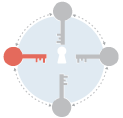MONITOR IMPACT
Measure social capital and impact of technical interventions
The many paradigm shifts SCALE+ represents (in comparison to a conventional development project) are reflected in the way results are measured.
Donor-funded projects are accountable for measuring sector-specific impact. Because SCALE+ works across sectors and is not restricted in the type of social change interventions it may support, intermediate results are likely to be more varied than those found in a traditional results framework. In addition, because SCALE+ aims to increase social capital within a given system, a project will also specify indicators and develop tools to help evaluate progress toward stronger stakeholder relationships and improved social cohesion, as one central project goal. SCALE+ uses the systematic and routine collection of information to learn from experiences to improve practices and activities in the future and to promote empowerment of beneficiaries using participatory monitoring and evaluation (M&E) of process and impacts to encourage collaborative problem solving.
Assistance in designing indicators and supporting participatory M&E processes, as well as ensuring the donor is in agreement with these, is an important contribution of the facilitator organization.
PARTICIPATORY ASSESSMENT
Develop traditional and innovative indicators
Projects using SCALE+ typically carry out baseline and endline surveys using in-depth interviews and monitor the process of technical inputs to measure changes in sector-specific indicators. Because system impact requires a cross-sector approach (social, economic, environmental, governance), SCALE+ helps stakeholders assess the results of their activities and project interventions in multiple sectoral areas. The Cross-Sector Advisory Committee and the Task Forces can shift resources on the basis of these assessments.
At the same time, projects that use SCALE+ collect information for social network analysis (SNA). SNA focuses on the flow of information within networks, on the strengths of ties between them, and on bridging across networks. Programs are able to graphically represent changes in the strength and nature of ties and in the density and cohesion of a system to illustrate the impact of the program on the enabling environment. SNA starts at the beginning of the project, preferably before or at the WSR retreat, to show connectivity in the system prior to project activities and then two or more times during the project. Collaborative actions are also tracked from the time of the WSR throughout the life of the project. The System Integration Team conducts monthly and quarterly interviews to monitor these actions and maintains a log that captures which organizations are involved and what assistance the project provided.
PROMOTE ADAPTIVE MANAGEMENT
Infuse commitment, responsibility, and accountability
Accountability is important with SCALE+ and receives a different kind of attention than in conventional projects. Whereas program implementers are usually held accountable to a donor, SCALE+ emphasizes mutual accountability among stakeholders—to each other and to their publically shared commitments.
This sense of accountability, as well as the celebration of incremental successes, is also supported by the facilitator organization, especially by the System Integration Team. Their monitoring activities and sharing even small achievements through a newsletter and other forms of communication reward efforts and stimulate sustained involvement. Each act of sharing information, loaning equipment, volunteering on a Task Force or agreeing formally to support an effort shows that the system is healthy and growing.
